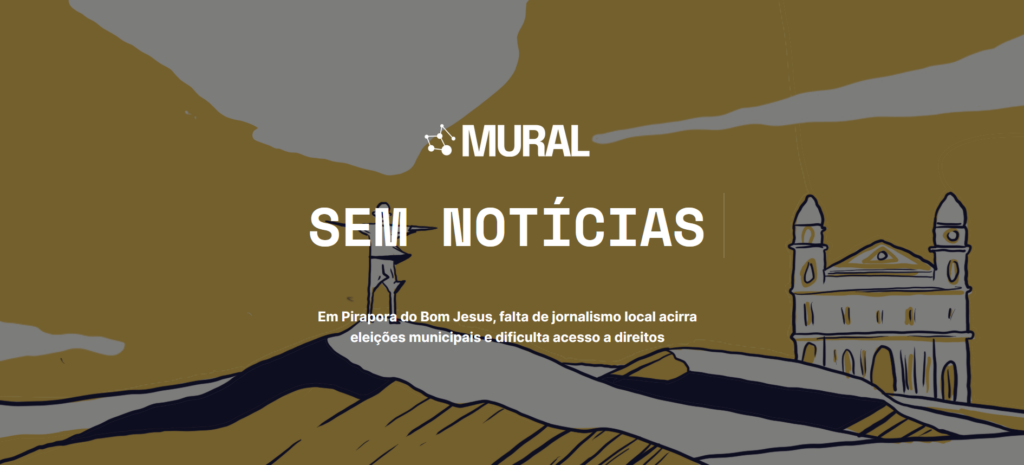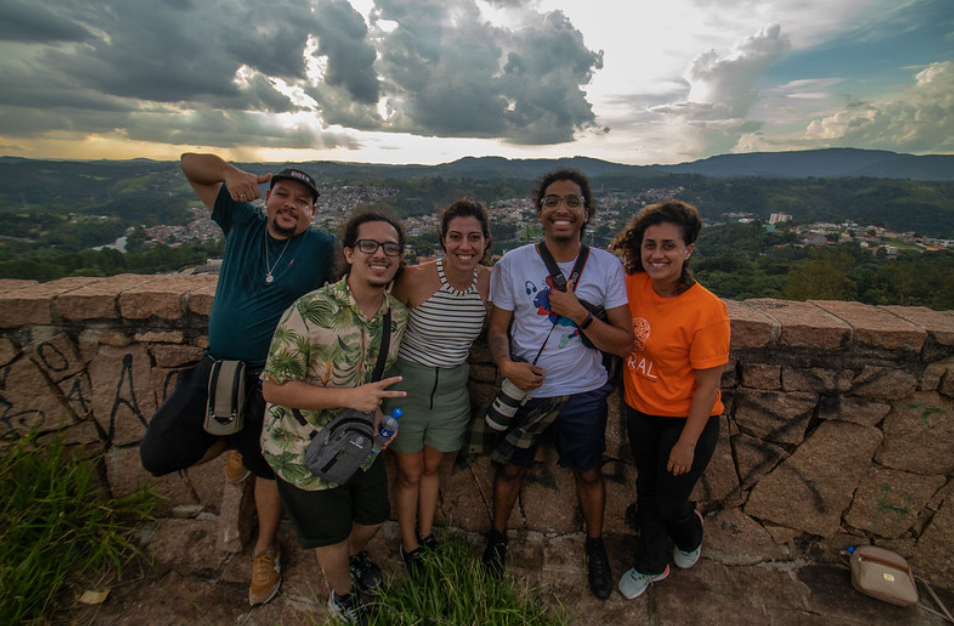Almost half (48.7%) of Brazilian municipalities do not have a journalistic outlet serving their population. There are 26.7 million people who have better access to news about São Paulo or Rio de Janeiro –where the so-called "national" media outlets are based– than about the city where they live.
The data comes from the 2023 edition of Atlas da Notícia, which has been mapping local journalism and news deserts in Brazil since 2017.
Digital media outlet Agência Mural de Jornalismo das Periferias has covered the impact of the lack of local reporting in the outskirts of São Paulo since at least 2018. In the beginning of 2024, Mural decided to tell the story of one of these deserts from the perspective of the people who live without reliable information about their surroundings.
The special “Sem Notícias” (Without News), published on June 4, tells what life is like in Pirapora do Bom Jesus, a city in the state of São Paulo with 18,370 residents and no local journalism. A team of five professionals from Mural – reporter, photographer, producer, cameraman and editor – spent five days, between April and May, in Pirapora, one of the 39 municipalities in the metropolitan region of São Paulo. The team spoke to residents to understand how they get information and how the lack of local journalism is felt in the city.
“Most people had never heard the term ‘news desert,’ but they quickly understood what it was about and found themselves in that reality,” Sarah Fernandes, editor and project coordinator from Mural, told LatAm Journalism Review (LJR). “Even though they were in a city without the press, without daily reporting, they generally realized the importance of having this and often regretted the fact that they didn't have it. We arrived there, perhaps, with a new question, which was not part of these people's daily lives, but which they had already thought about at some point.”

Multimedia special “Sem Notícias” explores life in a city without local journalism. (Screenshot)
The multimedia special was published in text, photo, audio, video and comics, bringing together all the formats in which Mural publishes its journalism, Fernandes said.
“When we were there, we weren’t really sure what the formats would be. We wanted to do video, photos and text, but as we heard some stories and got to know people, we realized that we could communicate some things better through illustration”, she said. “Perhaps, in these 13 years of Mural, this is the first work that manages to bring together all the languages we use. So for us, as an organization, it is also an important step.”
More than 15 people were interviewed, according to the report, including students, workers, community leaders and politicians. One of the meetings with city residents was held in a public school, with a class from the Youth and Adult Education (EJA) program. “We are each other’s newspaper,” one of the adult students said.
According to the report, Pirapora is a commuter town for a large part of the population, who work in other surrounding municipalities. It is also a “divided city”, Fernandes said, between the center and the outskirts, where the majority of the population lives.
Even in a small city without local journalism, the outskirts are the place most affected by the lack of information. Those who live closer to the centers of power, such as the city hall and the municipal chamber, end up having more access to information and, consequently, rights. This was one of the conclusions of the students in the conversation with the Mural team.
“It was a very rich conversation, which allowed us to understand how people are impacted in their daily lives by the lack of information,” Fernandes said. “And sometimes the information is not even a complaint about public authorities, but rather publicizing that a federal government program has arrived in Pirapora and is open for registration, for example. We hear from these people how much they miss opportunities to study, work, and develop due to the lack of this institutionalized information circulating, and how much the absence of local journalism exacerbates socioeconomic inequality.”

Agência Mural's team in Pirapora do Bom Jesus. (Photo: Léu Britto/Agência Mural)
Jacqueline Maria da Silva, a Mural reporter who went to Pirapora, told LJR that conversations in the city showed residents and journalists themselves the effects of the lack of local reporting and the importance of quality journalism.
“This is very important for us, journalists, because a lot of people talk about fake news as if it were something very banal, but in the news desert there is no way for fake news to be debunked,” Silva said.
“We hear so many [negative] things about journalism, it's so difficult, people devalue it so much... And this report warms our hearts to see people understand that journalism is important, even though there are many things that go against it and a lot of devaluation."
According to the report, Dubes Sônego, researcher at Atlas da Notícia, told Mural that one of the most striking aspects of news deserts is the perpetuation of the same political groups in municipal government. The special report also highlighted that the situation in Pirapora is that of a “political hotbed in a small city, with a weak economy, low socioeconomic indicators and no local and independent journalism initiatives based there to make counterpoints, complaints and investigations.”
This point was even manifested in the fact that many people refused to talk to the Mural team, citing fear of reprisals from those in power.
“It's a city with a very lively political scene, so people are very afraid of saying something that could compromise them with one political group or another. It was a really difficult investigation, because people were afraid and often attributed this fear to the lack of press. Something like ‘depending on what I say, I could be harmed, because there is no way to spread information or make a complaint here,’” Fernandes said.
Furthermore, Silva said that the team felt suspicious glances from residents while moving around the city.
“[Our presence] sparked a movement of people there. We were walking around with cameras in the middle of the week. (...) We recorded in front of the [Municipal] Chamber. When we entered the Chamber, we also felt that we aroused some discomfort,” she said.
The report identified that two political groups have taken turns in municipal power in Pirapora for at least 20 years. In the 2012 elections, the difference between the winner of the mayoral election and the candidate who received the second highest number of votes was just 28 votes. The lack of local journalism contributes to the lack of political literacy in the city and the spread of disinformation for political purposes, and this is a point of attention in 2024, the year of municipal elections, Fernandes said.
“It also limits a bit people from knowing exactly what each candidate's proposals are and from analyzing what each candidate is proposing, and from knowing what a councilor or mayor is supposed to do,” she said.
The report also highlights that journalism is not the solution to Pirapora's problems. Eugênio Bucci, professor at the School of Communication and Arts at the University of São Paulo (USP), was one of the sources for the special report and said that “journalism is a step towards solving problems.”
“The role of journalism is to encourage public debate, to provide information, to connect people with what is happening,” Fernandes said. “That’s why it has a very important role in democracy, reporting, oversight and monitoring. And we realize how much this is missed in people’s daily lives.”
The Mural team will have the opportunity to hear from the people of Pirapora themselves what they thought of the report, as the project, sponsored by the Pulitzer Center and Meedan, involves the team returning to the city to present the final article. The intention is to hold an event open to the community at the end of June, at the same public school that welcomed the team on its first visit to the city.